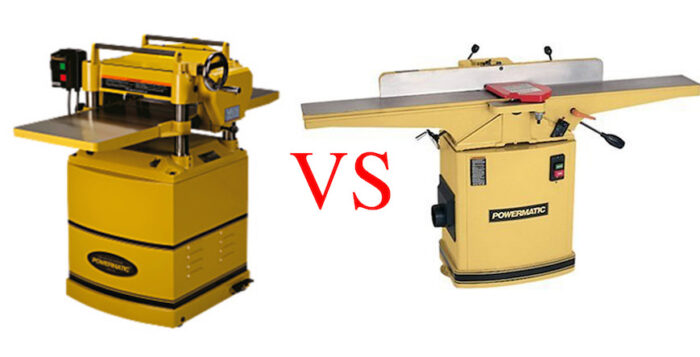Woodworkers rely on a range of essential tools to achieve quality results on their projects. Two of the most important are the jointer and the planer. While they both shape and smooth lumber in the woodworking process, they perform different roles. In this article we talk about Jointer vs. Planer Comparison – Knowing When to Utilize Each for Woodworking Success.
What is a Jointer?
A jointer is a stationary woodworking machine used to flatten one or more edges of a board and straighten any warping or cupping. This process produces one flat side, known as a reference face, as well as one straight and square edge along the board. The reference face and edge enable the woodworker to then feed the board through the planer to achieve uniform thickness and flatness on the opposite side.
Jointers have a long infeed table and a shorter outfeed table. These cast iron tables allow the wood to slide across the cutterhead mounted between them. The cutterhead contains two or more knives which spin at a high rate of speed to shave off a thin layer of wood as it passes over. This removes material and flattens the surface in contact with the outfeed table.
Why Flatten a Board on a Jointer First?
Flattening one face of a board on the jointer before sending it through the planer is an essential woodworking skill. Skipping this step and attempting to surface plane a board that is cupped or warped will produce inconsistent results and snipe, which are divots at board ends. This happens because an uneven board shifts position when contacting the planer.
Starting with a flat reference face enables even contact with the planer bed. This prevents snipe and facilitates uniform cuts across the entire width and length of the board. It also enables the woodworker to check for square as they work. Maintaining squareness helps pieces fit together accurately during assembly.
What is a Planer?
A planer is another integral woodworking machine. While a jointer flattens the face of a board, a planer reduces thickness and smoothes both wide surfaces. The cutterhead inside a planer typically has two straight blades. As the workpiece moves over the cutterhead, the blades slice off the top layer of wood to create a smooth, even surface.
There are a few types of planers:
Benchtop/Portable: Lightweight and suited for small jobs. The board width capacity is narrower.
Floor Standing: Heavier in weight and designed for larger scale work. Wider planing width capacity.
Handheld: Powered manually versus electrically. Mainly used for minor touch ups.
The process of running lumber through a planer is called surface planing or surfacing. It serves to reduce thickness and improve smoothness of both faces. While a jointer establishes an initial flat side, the planer makes the opposite side parallel. This produces boards of uniform thickness, which improves the fit of woodworking pieces.
Key Differences Between Jointers and Planers
While jointers and planers work sequentially to machine lumber, they serve separate primary functions:
Purpose:
Jointer: Flattens faces and straightens edges
Planer: Reduces thickness and smooths faces
Number of Surfaces Machined:
Jointer: One or two adjacent surfaces
Planer: Two opposite wide faces
Position:
Jointer: Stationary machine
Planer Benchtop: Portable but requires stable support
Planer Floor: Stationary machine
Depth of Cut:
Jointer: 1/8” max cut depth per pass
Planer: About 1/16” of an inch max cut depth per pass
Feed Direction:
Jointer: Runs wood pieces over cutterhead along or against the grain
Planer: Feeds wood over cutterhead perpendicular to grain
Cutting Mechanism:
Jointer: Two or more flat knives in cutterhead
Planer: Two straight blades in cutterhead
Ideal Sequence of Operations:
- Surface one face with jointer
- Surface one edge with jointer
- Set thickness and smooth both faces with planer
Tips for Proper Use of a Jointer
Follow these guidelines for safe and effective use of a jointer:
- Check lumber for defects like knots before machining
- Always feed workpieces over cutterhead in same direction
- Make light passes of 1/32” or less
- Use push blocks to surface pieces under 3” wide
- Stand to the side as you make cuts; avoid standing directly behind
- Keep guards in place and wear eye and ear protection
Tips for Proper Use of a Planer
These tips will help you safely use a planer to achieve quality results:
- Machine warped boards in increments to prevent snipe
- Make very shallow passes not exceeding 1/16 of an inch
- Feed wood perpendicular to grain to prevent tear out
- Plane both faces equally after jointing one face
- Check thickness with calipers frequently when taking light cuts
- Carefully inspect lumber for defects before planing
- Wear proper safety gear and maintain machine well
Achieving Success Woodworking with a Jointer and Planer
Jointers and planers are invaluable to woodworking success. While they perform uniquely, using them sequentially helps create flat, straight, and uniformly thick lumber. This enables properly machined workpieces that fit together accurately during project assembly. Following proper safety and operational techniques allows woodworkers to get the most out of these essential machines.
The key is understanding the distinct purpose and ideal use of jointers vs. planers. Flattening the reference face and edge with the jointer must precede thicknessing and smoothing the remaining faces with the planer. Mastering both machines and the order of operations is central to efficient woodworking and quality results. I sincerely hope you find “Jointer vs. Planer Comparison – Knowing When to Utilize Each for Woodworking Success” article helpful.


